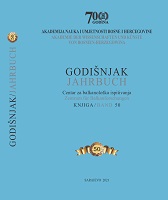O porijeklu zemljišne razdiobe sela Gornji Rujani (Retrogradna i metrološka analiza austro-ugarskog katastra)
About the Origin of Land Division in Gornji Rujani (The Reverse and Merological Analysis of the Austro-Hungarian Cadastre)
Author(s): Marko RimacSubject(s): Regional Geography, Local History / Microhistory, Middle Ages, 19th Century, The Ottoman Empire
Published by: Akademija Nauka i Umjetnosti Bosne i Hercegovine
Keywords: Gornji Rujani; retrograde cadastre analysis; land distribution/field system; Langsreifenflur; Gewannflur; baština i.e. virgate; infield; ancient surface units of measurement; dunum; jerib; gonjaj;
Summary/Abstract: This article is written on the basis of a reverse analysis of the Austro-Hungarian land survey for the cadastral community of Rujani in Livanjsko polje from 1883. The size of cultivable land in the hands of individual owners and tenants is determined on the basis of cadastral maps and parcel registers. According to the analysis of the location of parcels that compose such owners (aga’s) shares and (serf) possessions cohesive ownership-possession complexes are derived. Such ownership-possession complexes are compared with the hypothesis that the village of Gornji Rujani has preserved the land division from the early Ottoman and pre-Ottoman, even early medieval, period. Such land divisions, of the Gewannflur (i. e. Common field) and Langstreifenflur type that is determined in Gornji Rujani, are met in the areas in Europe influenced by Carolingian and post-Carolingian colonization. It is concluded that such type of land division is based on social-economic development of early medieval Croatia when villages comprised of calibrated villain or serf crofts (ždrijeb in Croatian) emerge after the collapse of the manorial system. They are mostly well known from the sources from the area of Zadar and Šibenik (ždrijeb sized 30 and 32 gonjajs of Zadar i.e. Croatian or Slavic gonjaj) and the results of the metrological analysis of the land division of Gornji Rujani point to the possibility that the rules of land division from that areas were widespread on the area possibly matching the spatial coverage of the early medieval Croatia engulfed by Carolingian expansion.
Journal: Godišnjak Centra za balkanološka ispitivanja
- Issue Year: 2021
- Issue No: 50
- Page Range: 187-214
- Page Count: 28
- Language: Croatian

